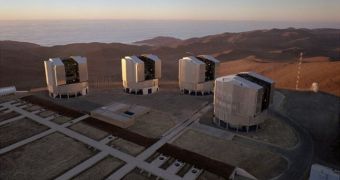For more than 50 years, radio astronomy has benefited from the capabilities of a process called interferometry, in gaining some of the sharpest images of the Universe possible with existing technologies. But, in spite of their positive results, astronomers operating these observatories failed to inspire their colleagues working with instruments that looked at the Cosmos in visible light wavelengths. But, now, optical interferometry is beginning to make its way in new optical telescopes, and the results of observations are clearly improving, Nature News reports.
One clear example is the Center for High Angular Resolution Astronomy (CHARA) observatory, which features a Y-shaped array of six one-meter optical telescopes. Each individual component would stand no chance in front of other telescopes on its own, but together, they all act as a single 33-meter mirror. This ability is what allows astronomers at CHARA to boast of producing some of the sharpest images of the Universe ever taken on our planet. This is all possible due to the fact that the Mount Wilson, California-based instrument uses interferometry.
What this means is that the light captured by each of the six telescopes is not analyzed and processed independently. Rather, underground tunnels carry the signals to a central hub, where they are joined together in a single beam. This allows for the entire array to behave like a single, large mirror, which would be unfeasible to build in real-life. Additionally, interferometry carries the advantage of offering a slight 3D perspective as well, given that all individual components in the array snap their images from different vantage points. This is the basis that allows for the images to be combined seamlessly into a larger, more clear photograph.
By using interferometry, CHARA is able to boast a resolving power about 50 times better than that of the orbit-based Hubble Space Telescope. The ground-based observatory can image relatively small details on the surface of distant stars, for example, which are only apparent in images from other telescopes as diffuse blobs of light. “This is moving us into a realm that radio astronomy has been able to enjoy for decades,” University of Denver in Colorado astronomer Robert Stencel explains. He is the coauthor of a new study, detailing data that CHARA collected of a distant binary system that puzzled astronomers for about a decade.

 14 DAY TRIAL //
14 DAY TRIAL //